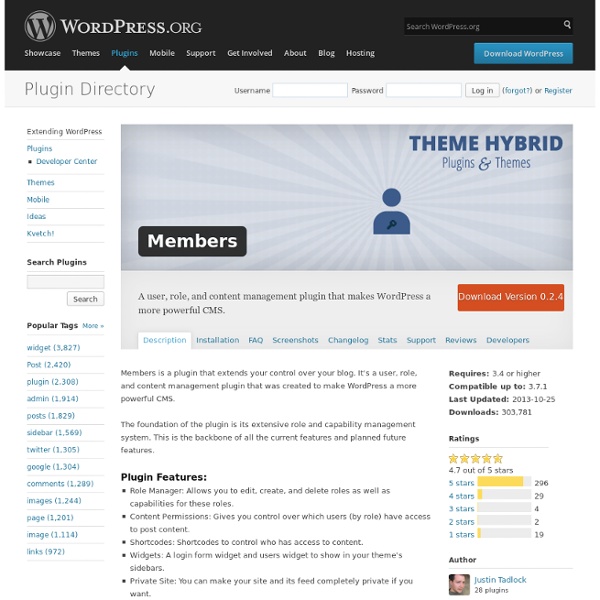WP-Members
WP-Members™ is a plugin to make your WordPress® blog a membership driven site. Perfect for newsletters, premium content sites, and more! The plugin restricts selected WordPress® content to be viewable by registered site members. WP-Members™ puts the registration process inline with your content (and thus your branded theme) instead of the native WP login page. WP-Members™ works "out-of-the-box" with no modifications to your theme, but it is scalable for users that want to customize the look and feel, or want to restrict only some content. It is a great tool for sites offering premium content to subscribers, and is adaptable to a variety of applications. Features: By default, WordPress® allows all content to be "open" and viewable by anyone and allows the site owner to restrict specific content if desired by setting a password for the post. The plugin installs with additional registration fields including name, address, phone, and email. What the plugin does not do
WordPress Access Control
Now with shortcodes and post/custom-post-type support, as well as a comprehensive admin interface for setting plugin defaults WordPress Access Control is a plugin designed to integrate into membership sites where certain pages, posts and custom post types should only be available to members of the site. The plugin offers fine tuned features for this purpose, including the ability to set site wide defaults and override these on a per-page basis. You can easily set a page to be accessible only by members of your site, or even a specific role. You can also set pages to be accessible only to non-members of your site, useful for registration pages. By default, you can add Members only pages to your menus, and users who cannot access them (non-members) won’t be able to see them. Additionally, you have the ability to customize search pages, completely hiding posts/pages from search results if a user can’t access them, showing search results without an excerpt, or showing search results normally.
Events Manager
Events Manager is a full-featured event registration plugin for WordPress based on the principles of flexibility, reliability and powerful features! Version 5 now makes events and locations WordPress Custom Post Types, allowing for more possibilities than ever before! Main Features Easy event registration (single day with start/end times)Recurring and long (multi-day) event registrationBookings Management (including approval/rejections, export CVS, and more!) Go Pro We have also released an add-on for Events Manager which not only demonstrates the flexibility of Events Manager, but also adds some important features: PayPal, Authorize.net and Offline PaymentsCustom booking formsCoupon CodesFaster support via private forums For more information or to go pro, visit our plugin website.
ThemeForest
WordPress Plugin - Typekit Fonts for WordPress
Typekit offer a service that allows you to select from a range of hundreds of high quality fonts for your WordPress website. The fonts are applied using the font-face standard, so they are standards compliant, fully licensed and accessible. This plugin allows you to embed and use Typekit fonts in your WordPress blog without having to edit your theme’s header or CSS files. To use this plugin you need to sign up with Typekit, install this plugin and then configure CSS for your site. Detailed instructions are available on the plugin’s settings page. Compatible with WordPress Multisite. This plugin is designed to function securely with both WordPress and WordPress Multisite. If the website is using HTTPS/SSL, the SSL version of the Typekit embed code is automatically used instead. Useful Links Change Log / Release Notes See Support / Questions Support questions should be posted to the Wordpress.org support forums.



